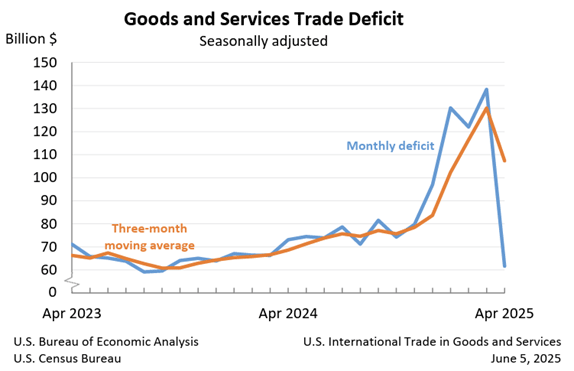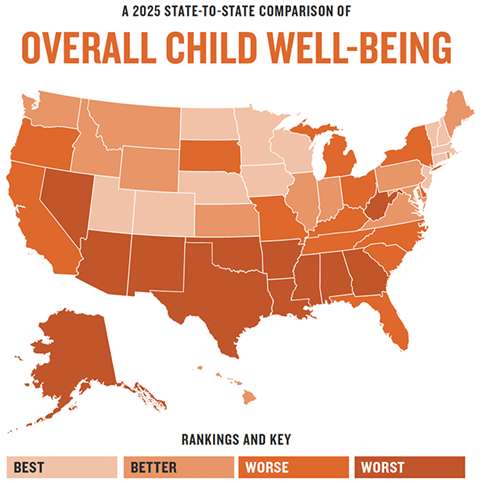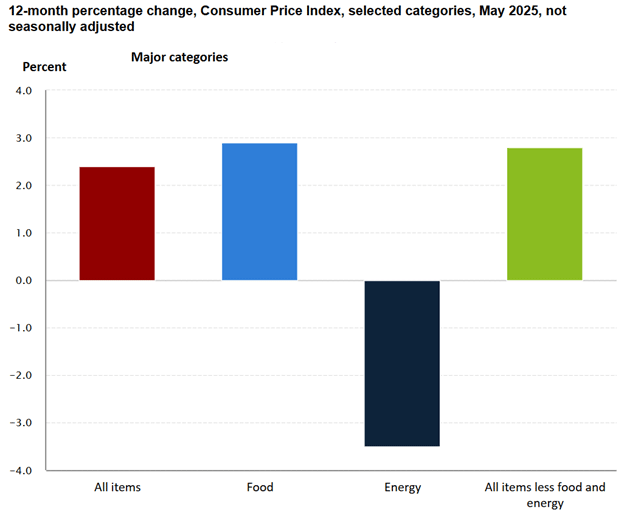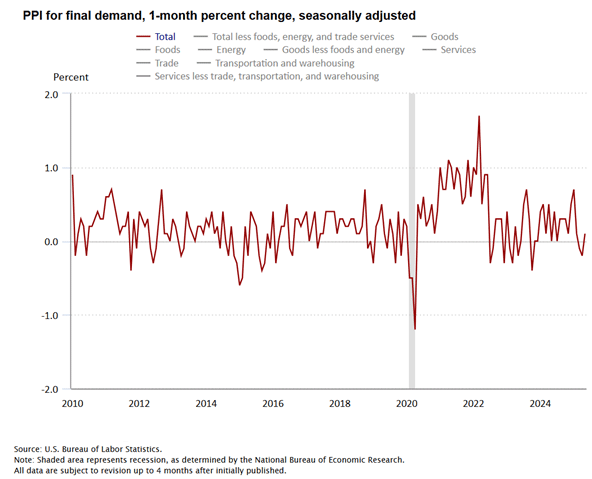Imports Crash as Tariff Expectations Evolve
EBRC Research Staff
Current data releases as of 13 June 2025
After rising to $138.3 billion in March, the U.S. trade deficit dropped to $61.6 billion in April, the largest one-month decrease on record. Imports decreased by $68.4 billion in April to $351.0 billion, a 16.3% drop. Exports were up $8.3 billion over the month to $289.4 billion. Year-to-date, the goods and services deficit was 65.7% higher than the same period in 2024. April data indicated the largest surpluses in billions of dollars were with Hong Kong ($6.9), Netherlands ($4.8), and the United Kingdom ($4.3). The largest deficits were with China ($19.7), European Union ($17.9), Vietnam ($14.5), and Mexico ($13.5). – Valorie Rice

The U.S. unemployment rate changed little in May at 4.2% while total nonfarm payroll employment increased by 139,000, according to the Bureau of Labor Statistics’ June 6th employment situation summary. Job gains occurred in health care (62,000), leisure and hospitality (48,000), and social assistance (16,000). Federal government employment continued to decline in May (-22,000), cutting 59,000 since January (paid leave or ongoing severance pay are counted as employed). Employment showed little or no change over the month in other major industries. In May, average hourly earnings for employees on private nonfarm payrolls rose by 15 cents (0.4%) to $36.24. The average workweek remained at 34.3 for the third month in a row. This release also revised March and April employment down by 65,000 and 30,000, respectively. -Delaney O’Kray-Murphy
The April 2025 release of the Job Openings and Labor Turnover (JOLTS) report stated that the number of job openings in the U.S. was little changed at 7.4 million, with a job openings rate of 4.4%. The number of job openings decreased in accommodation and food services (-135,000). Nationally, the number of hires was little changed at 5.6 million. In April, the hires rate was 3.5%, up from 3.4% in March and February. The number of total separations in the nation was little changed at 5.3 million, with a rate of 3.3%. The number of quits was little changed at 3.2 million with a rate of 2.0%. The number of layoffs and discharges changed little at 1.8 million and a rate of 1.1%. Layoffs and discharges increased in health care and social assistance (+52,000), but decreased in state and local government, excluding education (-14,00) and in federal government (-4,000). -Alex Jaeger
Almost 70% of the 369 largest counties in the U.S. had an increase in jobs between December 2023 and December 2024 based on the latest Quarterly Census of Employment and Wages (QCEW) release for the fourth quarter of 2024. Maricopa was among the counties with employment increases, posting a 1.0% change, just a bit higher than the nation at 0.8%. Pima was not among the counties with job gains, as it reported a 0.2% decline in employment year-over-year. The largest job increase over the year was in Kings County, NY, with a 5.3% gain. Buncombe County, NC, had the biggest drop in employment, at -5.0%. While Maricopa and Pima counties were split on employment, both posted increases in wages for the fourth quarter of 2024 with Maricopa having a rise of 6.8% and Pima 3.9%. Nationally, wages moved up 5.0% during that period. The over-the-year percent change in wages ranged from 15.0% in Santa Clara County, CA, to a decline of 7.7% in Lake County, IL. – Valorie Rice
Arizona remained among the states facing challenges regarding children’s well-being. The 2025 KIDS COUNT Data Book ranked Arizona 42nd overall, the same position it held in 2024. The report presents 16 indicators of childhood well-being focusing on four categories: economic well-being, education, health, and family and community. There were a few bright spots for the state in this year’s report. The rank for economic well-being improved slightly to 31st compared to 33rd last year. Within that category, the percentage of children in poverty has steadily declined in Arizona. Areas that remain troubling are education, where the state was below the nation on all four indicators, and health, where Arizona had the second-highest rate of uninsured children nationally. Only Texas posted a worse rate. The top states for overall child well-being in 2025 were New Hampshire, Vermont, Massachusetts, Utah, and Minnesota, while the lowest-ranking states were New Mexico, Louisiana, Mississippi, Nevada, and Oklahoma. – Valorie Rice

Source: The Annie E. Casey Foundation. (2025) KIDS COUNT Data Book.
The U.S. consumer price index for all urban consumers rose 0.1% over the month in May (seasonally adjusted), down from a 0.2% increase in April. Over the year, the all-items index was up 2.4%. The all-items less food and energy index rose 2.8% over the year in May. The energy index fell 3.5% while the food index rose 2.9%. The egg index was up 41.5% from May 2024. The gasoline index fell 12.0% over the year, while the electricity index rose 4.5%. The May data likely does not reflect much of the impact of recent increases in tariffs. -George Hammond

The U.S. producer price index for final demand increased 0.1% in May (seasonally adjusted), after falling 0.2% in April. The final demand index was up 2.6% over the year in May. The index for final demand goods rose 0.2% over the month in May, up from 0.1% in April, with core goods driving the increase. Prices for processed goods for intermediate demand rose 0.1% in May. Prices for unprocessed goods for intermediate demand fell for the third consecutive month in May, dropping 1.6%. – George Hammond






